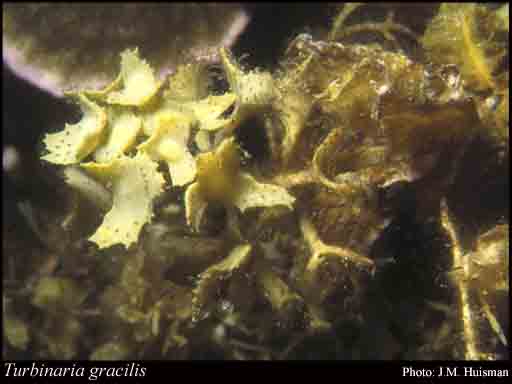- Reference
- Bot.Zeitung (Berlin) 3:52 (1845)
- Conservation Code
- Not threatened
- Naturalised Status
- Native to Western Australia
- Name Status
- Current

Scientific Description
Habit and structure. Thallus to 50 cm tall, the erect axes closely branched in small plants, sparingly branched in larger plants. Laterals 5–16 mm long, including the subterete stalk, (4–) 6–15 mm wide, the turbinate upper part rounded to deeply lobed, with ±entire or serrulate to dentate margins. Stalk 0.75–1.50 mm diam., flattened below, becoming angulate above. Vesicles ranging from a near dominance of the leaf to a vestigial float. Inflorescence (2–) 5–14 mm long, attached near the stalk base, almost racemose. Receptacles 1–3 (–5) mm long, terete, smooth, simple or forked.
Distribution. Known from Hamelin Bay, W.A. and around northern Australia to Qld.
Habitat. Epilithic in the intertidal and shallow subtidal.
[After Dixon & Huisman, Algae of Australia: Mar. Benthic Algae of North-western Australia, 1. Green and Brown Algae 273 (2015)]
Distribution
- IBRA Regions
- Carnarvon, Geraldton Sandplains, Pilbara, Swan Coastal Plain.
- IBRA Subregions
- Cape Range, Geraldton Hills, Perth, Roebourne.
- IMCRA Regions
- Abrolhos Islands, Central West Coast, Kimberley, Leeuwin-Naturaliste, Pilbara (nearshore), Pilbara (offshore), Zuytdorp.
- Local Government Areas (LGAs)
- Ashburton, Augusta Margaret River, Broome, Bunbury, Cambridge, Carnarvon, Cockburn, Cottesloe, Dandaragan, Greater Geraldton, Irwin, Karratha, Rockingham, Wanneroo, Wyndham-East Kimberley.